From Seed to Lawn: Part 2
- Milorganite AgronomistJune 30, 2018
The Adventures of One Homeowner
Experiences and lessons learned from starting a new lawn from seed
In my previous post on starting a new lawn by seed, I touched on the pros and cons of seed vs. sod, the best time to establish a new lawn, grading, and the most important factor of all, establishing a realistic budget—our’s wasn’t. Here I’ll cover the importance of selecting a good landscape contractor, topsoil, what to consider when selecting grass seed varieties, fertilizing, and watering, which happened to be the most stressful part of the entire experience.
Landscape Contractor, Final Grading
Through word-of-mouth and scouting the subdivision, we had a short-list of landscape contractors to contact. Some landscapers were half the cost of others and possibly less experienced. We looked at lawns the landscapers had installed at other properties. You could see the difference in the established lawns. We also knew we had to find a landscape contractor who could successfully work with a potentially difficult customer, one who knew a thing or two about turf, someone with very strong opinions on how to approach the project—me.
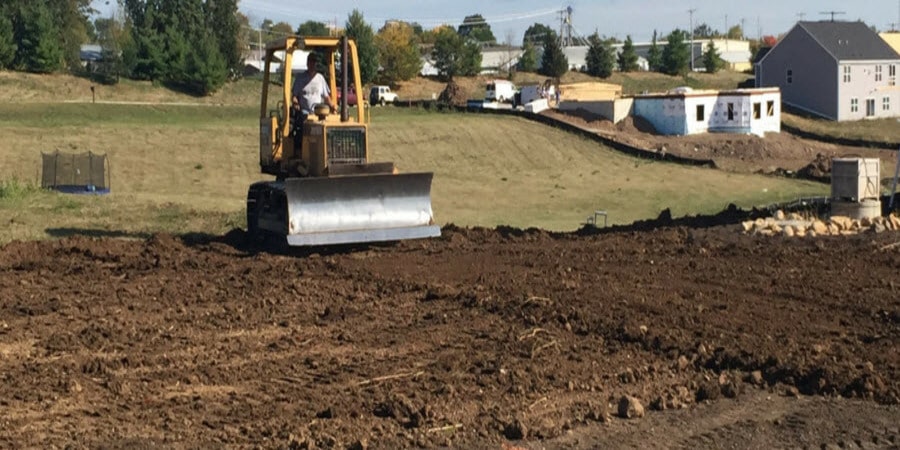
We decided on a local landscaper who knew the area, the land and had been involved in some of the subdivision’s development.
We’re grateful to have worked with a knowledgeable, reliable landscape contractor who walked us through the process of selecting topsoil, final grading, and seeding the lawn. His guidance was invaluable. We worked with him to decide the final grading of the property, to ensure we had the landscape we wanted and a proper slope so water to flows away from the house. We were grateful to have more input into the process than we expected.
We had several final grading options, including building a retaining wall. When we found out it would cost $20,000 or more, we opted to grade the backyard toward the lake as a long, gently sloping hill.
Topsoil
Originally, I envisioned putting down a mix of topsoil and high-quality compost. We quickly discovered that topsoil was all our expanding budget would allow. Our landscaper recommended a blend he normally uses and has always had good success. He’s had far more experience with topsoil than me. I trusted his choice.
We needed a lot of topsoil—far more than we ever expected. For a 2-inch layer on our property, the landscaper brought in over 200 cubic yards of topsoil. Around here, the cost of quality topsoil, delivered, is about $25-30 a yard.
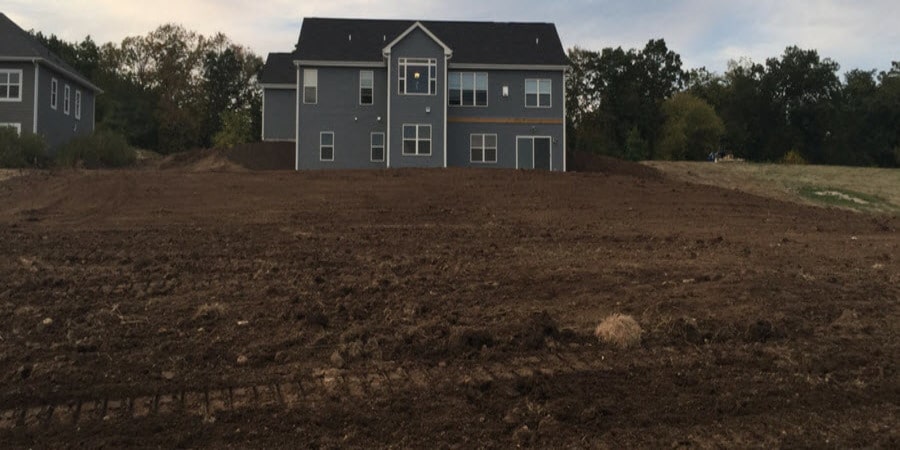
If you’re making the decision on topsoil without the guidance of a landscaper, work with a reputable supplier. Cheap topsoil may contain residual herbicides, pesticides or weed seeds, all of which can impede grass from growing. If the soil came from an old, overworked farm field, for example, the nutrients could be significantly depleted. Check with the supplier to find out from where the soil came before you buy it.
The soil was delivered, dumped in piles, spread using a skid steer, then fine-tuned using hand rakes.
Seed and Seeding
There are several factors when selecting the grass species to use, the first of which is determined by where you live: cool-season grasses in the North and warm-season grasses in the South, as well as combinations in other diverse climates throughout the country. Consider the growing conditions on your property and lifestyle as you select the type of grass seed to use. There are grass species better suited for shade or sun, soil composition, as well as wet or dry conditions. If you have a lot of traffic from kids and pets, consider a more durable grass species. If your goal is a showcase lawn, other species will work better.
Take a look at the National Turfgrass Evaluation Program map to help you narrow down your choices for grass varieties good for your area. You can also search online for other turfgrass climate zone maps for information. Probably the best source of information and advice on grass varieties specific to your area will be your local extension agency.
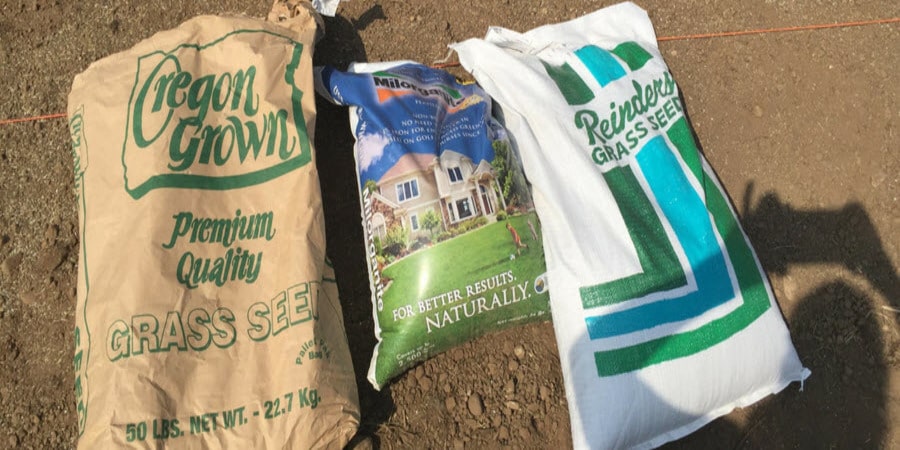
The time it takes for grass seed to germinate varies by species. Knowing this will help you manage your expectations and not think everything has died when it’s not even supposed to be sprouting yet.
We relied on our landscaper and his recommendation of what seed was best suited for our property. It was a combination of rye and fescue grasses, which germinates in about 7 days, and bluegrass, which takes much longer to germinate—about 21–36 days.
After distributing the seed, it was raked in by hand to ensure good contact between the soil and seed.
I’ve never been a fan of mulching newly seeded areas with hay. I was concerned about the potential for weed seeds being mixed in . I’ve changed my mind.
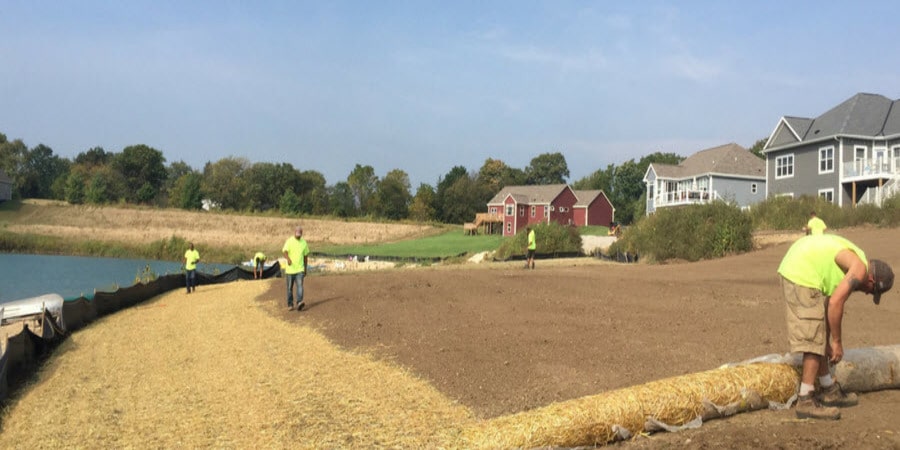
We used hay mats that were rolled out like carpeting and staked in place. The hay helps to keep the seed in place and the soil moist and cool—keys to success. There’s no need to rake up the hay; it’ll decompose and add organic matter to the soil.
Fertilizer
Our landscaper decided to fertilize before seeding, but you can also do both at the same time. Milorganite can be mixed with grass seed before it’s broadcast—four parts Milorganite mixed with one part seed by weight—which is particularly helpful with smaller, finer grass seeds. I also mix grass seed with Milorganite when overseeding. It makes the process easier and saves time.
It’s best to provide newly seeded lawns with all the nutrients it needs from the start, so we also used a starter fertilizer, which is blended specifically for new lawns. It provides nitrogen to help with germination and top growth, and a quick shot of phosphorus for better root development. Milorganite is a slow-release, low-nitrogen fertilizer for prolonged feeding would be a good choice. It won’t burn the emerging seedlings and significantly reduces the risk of runoff.
Application rates vary depending on grass variety, soil type, organic material present, and local fertilization restrictions. In general, use 50–100 lbs. of Milorganite per 1,000 sq. ft. for sandy soil and 25–50 sq. ft. for native soil. Also use the higher rate for soil that would benefit from additional organic matter and grass varieties that prefer higher amounts of nitrogen, such as Kentucky bluegrass and Bermuda grass.
Watering
Watering a newly seeded lawn sounds fairly easy, right? Well, it was the most challenging part of the process.
Maintaining even moisture for the first couple of weeks is critical for grass seed to germinate and grow. There are several options for irrigation systems and costs vary greatly.
We got a quote of $2,500 to rent an irrigation system for only a few weeks. By comparison, the investment in a permanent irrigation system would have been between $2,500 and $5,000. A rental certainly didn’t make sense considering the cost comparison. We also decided to not install a permanent irrigation system, since I prefer to allow my lawn to go dormant during periods of drought. If you’re the same, you may even consider opting out of an irrigation system in warmer climates if you don’t need to have a pristine lawn through winter.
We opted for a low-tech irrigation system: an oscillating sprinkler and more than 150 feet of hoses.
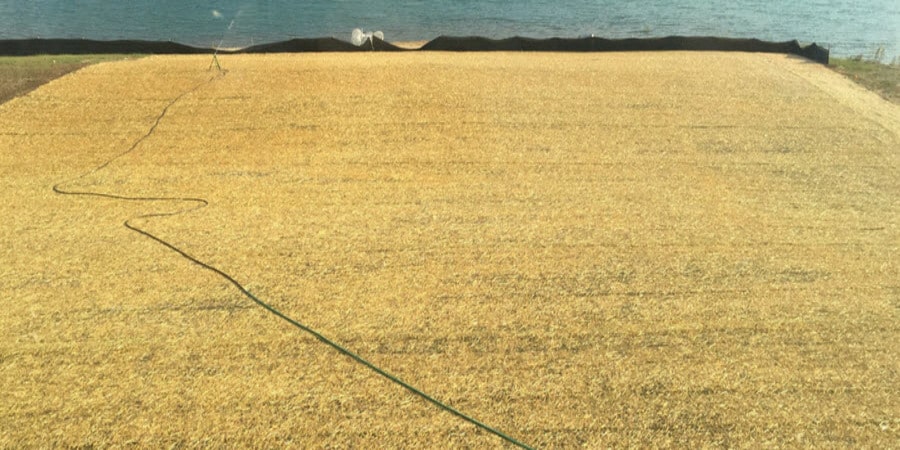
We purposely waited until mid-September to seed the lawn when “the weather got cooler.” What we didn’t expect was two weeks of unseasonably hot temperatures in the 90s, which is completely unexpected where we live. Watering doesn’t sound stressful, but for us, because of the heat, it was.
The soil was drying out very quickly. Watering became a second job for us—a nine-hour-a-day job. The thought of possibly losing our investment because of hot weather just made me sick. We had to go to extremes to keep our lawn watered. I’d water before leaving for work and come home to immediately water again hoping it had survived the day. My husband and I took days off from work to stay home and move sprinklers. There were even times we had to ask our parents to “babysit” the lawn to make sure we maintained our frantic watering schedule.
Watering was the topic of a few “lively discussions” between my husband and me. Whoever thought we would fight over how long to run a sprinkler.
I’m the agronomist!
There are a lot of options to consider when installing a new lawn by seed or any other method. Your budget will likely be your most significant criteria for making final decisions. The best rule-of-thumb is to purchase the highest quality product and hire the best landscaper your budget allows.
Part 1 - Budget, Timing, Rough Grade, Seed vs Sod
Part 2 - Final Grade, Topsoil, Seeding, Fertilizing, Watering
Part 3 - Dog spot, Disease, Overseeding, Weeds, Settling

